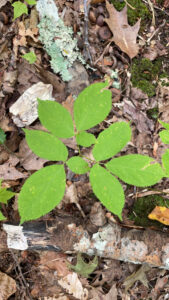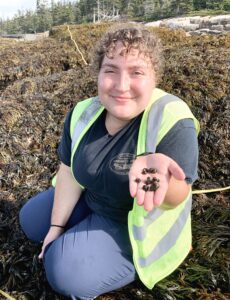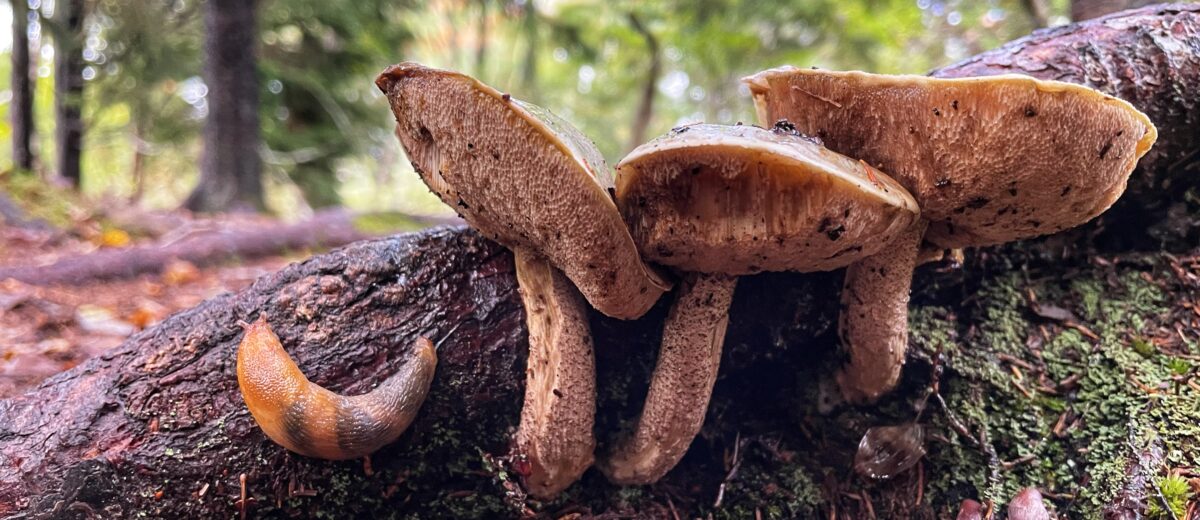story + photos by Emily Jackson, 2021 Schoodic Institute Ecology Technician
Before coming to work and live at Schoodic Institute, I knew how to identify a fair number of plants and animals by sight and sound. The feathery look of yarrow leaves and the repetitive call of the Whip-poor-will are two of my favorites. At home, in our big old field in the foothills of the White Mountains, I knew which species marked the passage of the seasons. I kept track of when the bobolinks fledged, when they migrated, and which wildflowers were in bloom. I also knew how to predict what the weather might be based on the sky, which was quite helpful during thunderstorm season.

But now, after an entire summer of working along the coast of Schoodic Peninsula, I have learned so much more. I can now identify Northern bayberry, black crowberry, and wild sarsaparilla. I have learned the species along the rocky coast of Schoodic Point that mark the passage of summer are surprisingly different from those at home. Here at Schoodic, I have been listening to the various songs of the frogs, and watching the constant procession of ripening berries and emerging fungi. I have also learned that the weather patterns here are different. The most obvious difference is the ever-present fog, which rarely appears inland. Another difference is the thunderstorms; clouds that would indicate an approaching storm at home never seem to result in anything here.
All this took time and repeated observations for me to learn. While I developed many of these skills working my job, there are a few things I have tried to do this summer on my own to enhance my learning. These are also things anyone can do to become a better naturalist wherever they may be.
First – Go outside! More specifically, go to the same place repeatedly over the course of many months. This helps you to tune in to what is present in the area, and what is changing. By repeatedly visiting the same location on one island this summer I have become very familiar with the phenology of three-toothed cinquefoil. This is a low growing plant that is found in rocky exposed areas, with little white flowers that eventually fade to small dried up seed pods. This time of the year you would be lucky to find one flower. However, earlier in the season, around July, there are whole mounds of cinquefoil in bloom. Visiting these locations all summer allowed me to observe and learn first hand how three-toothed cinquefoil changes throughout the season.

Second – Make an effort to identify something every time you go outside! Even if you know you will forget it in 10 minutes, or if you think you already know what it is. Repetition is key, and repetition breeds familiarity. This can help you confidently identify something when you find it where you don’t think it normally occurs. For example, I have been working with a species called black crowberry a lot this summer. I know crowberry grows in rocky, exposed areas on the coastline and mountain tops, and sometimes a few meters into the forest edges. Recently, I was walking through a quaking bog and I spotted what was most definitely and most surprisingly black crowberry. However, a bog is the complete opposite habitat from where I had been finding it all summer. My familiarity with the plant allowed me to confidently identify it in an environment that was completely unexpected.
Third – Use resources! Not everyone can ask an expert to help them identify things, and not everyone has access to identification guides on every type of organism they might encounter. However, most people do have access to the internet. This summer I have downloaded several apps to help with identification: iNaturalist, Seek, and Merlin Bird ID are the three I use the most based on what interests me. I also frequently use Google to help confirm that these apps gave me the correct information. I often search for something like “yellow-crowned night heron range” (Yes, I really saw this bird. Yes, Seek accurately identified it for me. And no, it’s range doesn’t really include Maine). I also use a website called Go Botany. It contains a really user-friendly online dichotomous key, and will list many of the defining characteristics of a plant that allows you to tell them apart from other similar species.
These three practices have really helped me over the summer, and are tools I will continue to employ as I grow as a naturalist. As my time here at Schoodic comes to a close, I am excited to move on and get to know new places as intimately as I have gotten to know the beautiful coastline here. I hope you will be able to use some of these tools yourself as you explore the natural world. Happy exploring!

